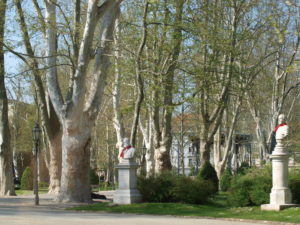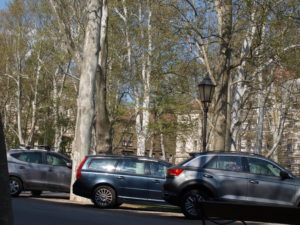


It was just before coronavirus outbreak in Croatia that my colleague Nevena Skrbic Alempijevic and I had a public presentation of our book The City as Encounter. Ethnographies of Zagreb Squares (in Croatian). Three years of ethnographic research have resulted in a book that describes daily activities and rhythms, public events, gatherings, practices, embodiment, affects, meanings and identities in/of several squares-parks in downtown Zagreb and traces transformations of public spaces and urban habitus in the Croatian capital. The newspaper reviewer of the book titled his article “I stroll, therefore, I exist” summarizing by that paraphrase what is the underlying notion of our study: that being-in-the-square is the epitome of social, political, affective and engaged urban existence. Three weeks later, squares have been emptied and the book has immediately become a historic record of Zagreb urban life and public culture of the past era – Zagreb BC, before Corona. And without strolling, what about our urban existence?
The emptying of squares started even before the official lockdown was proclaimed in mid-March. A familiar urban scene on Saturday morning would be crowded squares full of citizens and tourists, cafes, children playing and cycling around, street musicians playing, costumed characters strolling and carriages driving around. These various activities evoke the Zagreb spirit from the beginning of the 20th century that also include traditional souvenirs sold at mobile stalls, various workshops organized in the park, groups of religious people singing, protesters for some issue and friends sitting and chatting on the grass. My interlocutor, who lives downtown recently sent me a video clip from early March filmed on a Saturday from his window where there were only a few people on Zrinjevac square with a police car cruising around alerting people by the megaphone to go home. There was something frightening and almost war-like in that scene and megaphone sound that made me shudder. Public spaces have become ghostly and empty soon after.
In a few days, however, a new situation emerged. Zagreb was hit by a serious earthquake on Sunday, 22nd of March at 6.24am. After the first two quakes (5,5 and 5,0 by Richter magnitude scale) many people left their flats and – in the midst of social distancing measures – started to gather on public spaces around their buildings. Many families and neighbours sat together in one’s car as this seemed to be a better solution than to stay in the flats. The park in front of my building in the southern part of the city was full of people: they were standing, individually or in small groups, scattered all over the large meadow, distancing 2-3 meters in between. It crossed my mind that the scene resembled a choreographed flash mob performance. Moreover, after a month of sunny and spring weather, the Sunday morning greeted Zagreb citizens with extreme cold and light snow. The popular meme commentary that appeared on social media combines all three Zagreb difficulties that morning: “I hate when the earthquake tears down my snowman while in the quarantine.” Joking aside, the material damage caused by the earthquake was huge, particularly in the downtown. The buildings from late the 19th and early 20th centuries around the squares that were focus of my research were damaged by cracks, roofs fallen in and walls cracked. Squares and parks in the city center hosted residents of surrounding buildings, people frightened for their lives, shivering from the stress and cold weather, some covered with blankets, awaiting to see whether a new quake would appear and looking around what could happen next. For that Sunday morning the void of open public spaces had temporarily become safe spaces for many citizens who felt threatened by the built environment. And it all happened during the social distancing and “stay at home” protective measures against the coronavirus pandemic. The circumstances created a contradiction – empty public space was required for health safety while full public space was instantly created for “life” safety. Both of these perspectives and experiences changed the meanings of downtown squares in a way that could not had been noted down or even imagined in my previous research but that will certainly become a turning point in future urban narrations.
A week later I took a fieldwork walk through the downtown squares. I was almost the only one there. I met a woman and her pet: a woman wore protective mask on her face, a dog was leashed and walked behind her leg. We were on the same route but we avoided each other. The squares and parks were empty of people but filled with cars parked on the edges and between trees. The parking is not allowed, but the earthquake provoked new practices which were tolerated by the Municipality as it was safer to park near the open spaces rather than the damaged buildings from which ruined parts were falling occasionally. Many buildings were fenced in order to prevent people walking near them. As there was no traffic in the city center at that time (tram lines were suspended and there were no cars driving around), the few citizens outdoors were walking in the middle of streets in order to keep safe. Still, the traffic lights were working giving me the impression of regular street order and everyday rhythm. However, it was a pretty thin impression of normality while the emptiness of the squares was omnipresent. There was a strange affective intensity between me and the space. The fact was that there were no humans present at that moment whose dynamic would certainly attract my attention visually, haptic, audibly. It made me think how our complete urban sensory environment is changed. Detached from human presence, I became excited by the new sight on the square: numerous and huge plane trees stood as artistic anthropomorphic monuments on their own. The emptiness of regular sounds of traffic and human voices was also an unusual sensation but again captured by different kind of sounds that could be heard when other human-made sounds are silenced – loud bird singing.
There are many “lost” sounds in public spaces that we are used to and which help us navigate through the city from human steps to car brakes. Now there are sounds of nature that we hear better and also some new sounds that have become saturated with social meaning like applauding for health workers, singing popular national songs for encouragement after the earthquake or making noise with pans protesting against the mayor’s way of running the city. If we cannot gather, socialize and stroll to confirm our urban existence by being-in-the-public-spaces, we can alternatively make sounds from our private homes, standing at the liminal space of windows and fill in public space with sounds which act as statements. It helps us to collectively share meanings and actions, at least to encounter fellow citizens through the ether, and to create publicness in public space that corresponds to a strange way of life in these unusual times. And this might creatively inspire us for future usual times and public life A.C. – Zagreb after corona.
Valentina Gulin Zrnic, Institute of Ethnology and Folklore Research, Croatia
http://www.citymaking.eu/en/


